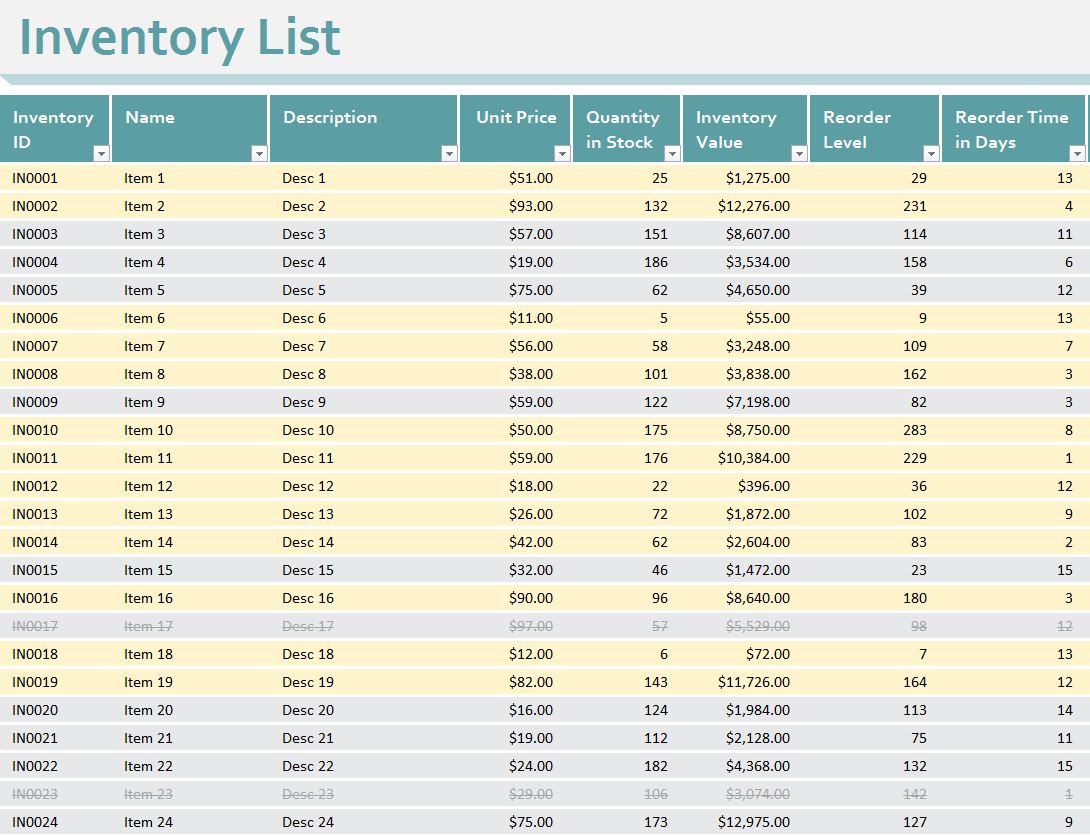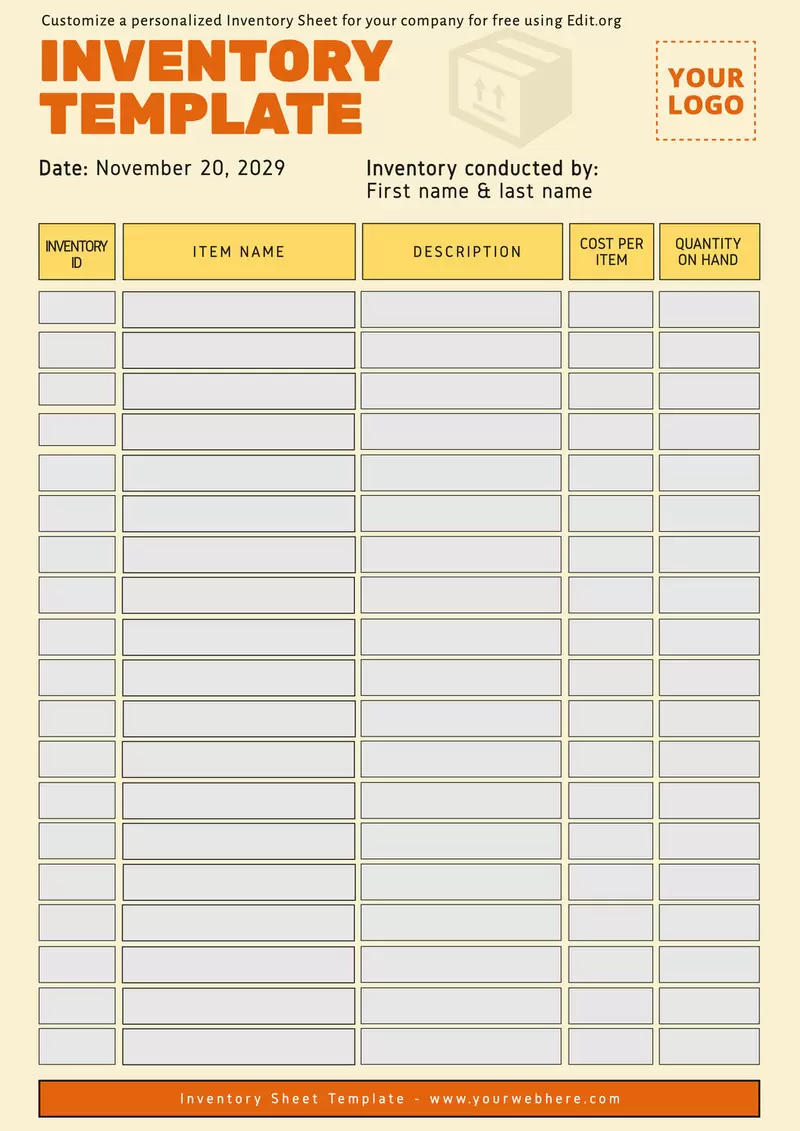
Mastering Your Stock: The Indispensable Business Inventory Spreadsheet
In the bustling world of commerce, where every product, every component, and every raw material holds monetary value, effective inventory management is not merely a best practice – it is the bedrock of operational efficiency, customer satisfaction, and ultimately, profitability. From a small e-commerce startup to a rapidly expanding retail chain, the ability to know what you have, where it is, and when you need more is paramount. While sophisticated Enterprise Resource Planning (ERP) systems and dedicated Inventory Management Systems (IMS) exist for large enterprises, many small and medium-sized businesses (SMBs) find their most reliable and cost-effective solution in a tool they already possess: the humble yet powerful business inventory spreadsheet.
This article delves into the critical role of a business inventory spreadsheet, exploring its myriad benefits, essential components, how to create and optimize one, and when it might be time to consider more advanced solutions.
The Unseen Costs of Poor Inventory Management
Before we extol the virtues of a well-crafted spreadsheet, it’s crucial to understand the challenges it addresses. Poor inventory management can lead to a cascade of problems:
- Stockouts: Running out of popular items means lost sales, frustrated customers, and potentially damaged brand reputation.
- Overstocking: Holding too much inventory ties up capital, incurs storage costs (warehousing, insurance), and increases the risk of obsolescence or spoilage.
- Shrinkage: Loss of inventory due to theft, damage, or administrative errors directly impacts the bottom line.
- Inefficiency: Wasted time searching for items, manual counting errors, and disjointed purchasing processes drain resources.
- Poor Cash Flow: Capital trapped in unsold goods is capital that cannot be invested in growth, marketing, or other critical business areas.
A robust inventory management system, even a basic spreadsheet, acts as a bulwark against these costly pitfalls.
Why Choose a Spreadsheet for Inventory Management?
For many SMBs, the inventory spreadsheet is the ideal starting point, offering a compelling blend of advantages:
- Cost-Effectiveness: Software like Microsoft Excel, Google Sheets, or Apple Numbers are often already installed or available for free, eliminating the need for significant upfront investment in specialized software.
- Accessibility and Familiarity: Most business owners and their staff have a basic understanding of spreadsheets, reducing the learning curve associated with new systems.
- Customization: Unlike off-the-shelf software with fixed fields and functionalities, a spreadsheet can be tailored precisely to the unique needs of your business, your products, and your workflows. You define the columns, formulas, and reporting structure.
- Flexibility: As your business evolves, your spreadsheet can easily adapt. Add new columns, change formulas, or restructure data without rigid system limitations.
- Data Visualization and Analysis: Spreadsheets excel at organizing data. With a few clicks, you can create charts, graphs, and pivot tables to visualize trends, identify best-sellers, or pinpoint slow-moving inventory.
- Scalability (for SMBs): While not suitable for multinational corporations, a well-designed spreadsheet can effectively manage hundreds, even thousands, of SKUs for small to medium-sized businesses.
Essential Components of an Effective Inventory Spreadsheet
To transform a blank sheet into a powerful inventory management tool, you need to populate it with the right data fields. Here are the core columns every business inventory spreadsheet should include:
- Item ID / SKU (Stock Keeping Unit): A unique identifier for each product. This is critical for accurate tracking and avoiding confusion between similar items.
- Item Name / Description: A clear, concise name and brief description of the product.
- Category: Grouping items (e.g., "Apparel," "Electronics," "Raw Materials") helps with analysis and organization.
- Supplier Information: Name, contact details, and perhaps supplier ID for easy reordering.
- Unit Cost: The cost to your business for each individual item.
- Selling Price: The price at which you sell the item to customers.
- Quantity In Stock: The current number of units available. This is the most dynamic field.
- Reorder Point: The minimum quantity level that triggers a new order. This prevents stockouts.
- Reorder Quantity: The ideal number of units to order when the reorder point is hit.
- Location (Warehouse/Shelf): Specific physical location of the item for quick retrieval.
- Date Last Updated: A timestamp indicating when the inventory count for that item was last verified or adjusted.
- Sales Data (Optional but Recommended): Columns to track units sold over specific periods (e.g., "Weekly Sales," "Monthly Sales") can inform reorder points and purchasing decisions.
- Notes: Any additional relevant information about the item.
Advanced Features to Supercharge Your Spreadsheet
Beyond basic data entry, leverage spreadsheet functions to automate and enhance your inventory management:
- Formulas for Calculated Fields:
=SUM(): Calculate total value of inventory (Quantity In Stock * Unit Cost).=IF(): Create conditional alerts, e.g.,=IF(D2<F2, "Reorder Now", "OK")where D2 is Quantity and F2 is Reorder Point.=SUMIF(): Calculate total value or quantity for specific categories.
- Conditional Formatting: Visually highlight critical information. For instance, automatically turn the "Quantity In Stock" cell red when it falls below the "Reorder Point."
- Data Validation: Prevent errors by restricting data entry to specific types (e.g., numbers only for quantity, a dropdown list for categories).
- Filters and Sorting: Quickly find specific items, sort by quantity, category, or sales performance.
- Pivot Tables: Summarize and analyze large datasets. Identify your fastest-selling products, your most profitable categories, or items nearing obsolescence.
- Graphs and Charts: Visualize inventory trends, sales performance, or stock levels to gain quick insights.
Steps to Create and Maintain an Effective Inventory Spreadsheet
- Define Your Needs: What information is crucial for your business? What reports do you need?
- Choose Your Platform: Excel for desktop power, Google Sheets for cloud collaboration.
- Set Up Your Columns (Headers): Use the essential components listed above as a starting point.
- Populate Initial Data: Accurately enter all existing inventory. This might require a physical count.
- Implement Formulas and Features: Add calculated fields, conditional formatting, and data validation rules.
- Establish Update Procedures: Decide who is responsible for updates, how often, and how sales/purchases are recorded. Consistency is key.
- Regular Review and Maintenance: Periodically reconcile your spreadsheet with physical inventory counts to catch discrepancies. Clean up old data or discontinued items.
Best Practices for Spreadsheet Inventory Management
- Accuracy is Paramount: "Garbage in, garbage out." Double-check all entries, especially quantities and costs.
- Consistency: Use consistent naming conventions and SKUs.
- Regular Updates: Update your spreadsheet immediately after sales, returns, and new stock arrivals. Real-time (or near real-time) data is crucial.
- Backup Your Data: Whether it’s cloud-based (Google Sheets) or local (Excel), ensure your inventory file is regularly backed up to prevent data loss.
- Train Your Team: If multiple people manage inventory, ensure they understand the system and follow the established procedures.
- Start Simple, Then Expand: Don’t try to build an overly complex system from day one. Get the basics right, then add features as needed.
- Physical Counts: Even with a meticulous spreadsheet, conduct periodic physical inventory counts to reconcile with your digital records and identify discrepancies.
Limitations of Spreadsheets and When to Upgrade
While powerful, spreadsheets do have their limitations, especially as a business grows:
- Manual Data Entry: Prone to human error and time-consuming.
- Lack of Real-time Integration: Doesn’t automatically connect with POS systems, e-commerce platforms, or shipping carriers without complex add-ons or manual intervention.
- Scalability Challenges: Becomes unwieldy with a very large number of SKUs, multiple locations, or high transaction volumes.
- Multi-User Access Issues: While Google Sheets excels here, simultaneous editing in Excel can be problematic without cloud solutions.
- Security: Less robust security features compared to dedicated IMS.
- No Advanced Features: Lacks features like barcode scanning, automated reordering, demand forecasting, or multi-warehouse management out-of-the-box.
When to consider upgrading:
If you find yourself spending an excessive amount of time on manual data entry, frequently encountering stock discrepancies, struggling with multiple locations, needing advanced reporting, or experiencing rapid growth, it might be time to explore dedicated inventory management software or ERP systems. These systems offer automation, integration, and robust features that spreadsheets simply cannot replicate.
Conclusion
The business inventory spreadsheet stands as a testament to the power of simple tools when applied thoughtfully. For small and medium-sized businesses, it offers an accessible, flexible, and cost-effective pathway to organized, efficient, and profitable inventory management. By meticulously tracking stock, understanding demand, and making informed purchasing decisions, businesses can avoid costly mistakes, enhance customer satisfaction, and free up capital for growth. While it may eventually be outgrown, the discipline and insights gained from mastering your inventory through a spreadsheet provide an invaluable foundation for future success. Embrace the power of the spreadsheet – it might just be the most impactful business tool you already own.

